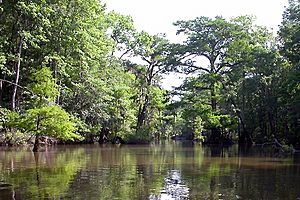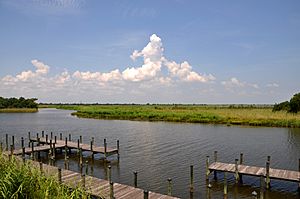Mobile–Tensaw River Delta facts for kids
Quick facts for kids Mobile–Tensaw River Delta |
|
|---|---|

Bottle Creek in the Mobile–Tensaw River Delta
|
|
| Location | Alabama |
| Area | 260,000 acres (110,000 ha) |
| Designated: | May 1974 |
The Mobile–Tensaw River Delta is a huge natural area in Alabama. It's the biggest river delta and wetland in the state. Imagine a giant watery forest! This delta covers about 260,000 acres, which is like a big rectangle 40 miles long and 10 miles wide. It's actually the second largest delta in the whole contiguous United States.
The delta starts where the Tombigbee and Alabama rivers meet. From there, it flows south. It eventually opens into Mobile Bay through several rivers. These include the Mobile, Tensaw, Apalachee, Middle, Blakeley, and Spanish rivers. The delta is found in parts of Baldwin, Clarke, Mobile, Monroe, and Washington counties.
Contents
Exploring the Delta's Environment
The Mobile–Tensaw Delta is super important for nature. It has many different types of places where plants and animals live.
Amazing Habitats in the Delta
You can find many cool habitats here. These include:
- Wet flood plains
- Cypress and gum swamps
- Salty brackish water marshes
- Forests along rivers called bottomland forests
- Underwater grass beds
Rich Biodiversity: An American Amazon
This delta is one of the most diverse places in Alabama and the United States. It's like a giant natural zoo!
- It's home to 126 kinds of fish.
- You can find 46 types of mammals.
- There are 69 kinds of reptiles.
- About 30 types of amphibians live here.
- At least 300 kinds of birds visit, and over 110 of them build their nests here.
Because of all this amazing wildlife, a famous scientist named E. O. Wilson called the delta an "American Amazon."
How the Delta Formed Over Time
The Mobile–Tensaw Delta sits in a river valley. This valley started to form millions of years ago. Many small streams from inland joined together. They flowed south over land that used to be covered by the Gulf of Mexico.
Delta's Ancient Past
About 18,000 years ago, at the end of the last big ice age, the sea level was much lower. Alabama's coast was about 60 miles farther south than it is today. The delta's waterways stretched much further south back then. As the ice age ended, the world got warmer. Sea levels rose again to where they are now.
A Look at the Delta's History
People have lived in the delta region for at least 5,000 years.
Ancient Cultures and Early Settlers
During the Mississippian period, people from the Pensacola culture built large earthen mounds. You can still see some of these mounds along Bottle Creek and the Tensaw River. Later, other groups moved into the area. These included the Taensas (Tensaw), the Creek, and the Choctaw people.
European Arrival and Conflicts
In the 1500s, Spanish explorers visited the area. French explorers arrived in the late 1600s. They eventually started a settlement called colonial Mobile in 1702. It was located on the Mobile River.
During the Creek War in 1813, a group of Creek warriors attacked Fort Mims. This fort was near where the Alabama and Tombigbee rivers meet. Many people at the fort were killed during this attack.
The Ship Clotilda and Its Legacy
On July 7, 1860, a ship called the Clotilda arrived in the Delta. It was carrying 103 people from West Africa. They had been captured in Dahomey and forced into slavery. The ship was then sunk on purpose to avoid legal trouble. This was the last slave ship to bring enslaved people to the United States across the Atlantic Ocean.
After slavery ended, many descendants of the Clotilda passengers created a community. They built the neighborhood of Africatown in Mobile.
Civil War and Modern Connections
The last important battle of the American Civil War happened in the delta. It took place at a fortified town called Blakeley.
Later, in 1872, a railroad line was built across the delta. It connected Mobile to Montgomery. Today, this is part of the CSX train system. In the 1920s, the Causeway was built. This road crosses the lower part of the delta. It connects the east and west sides of Mobile Bay. Even later, major highways like I-65 and I-10 were built across different parts of the delta.
The delta was recognized as a National Natural Landmark in May 1974.
Fun Things to Do in the Delta
The Mobile Delta is a great place for outdoor fun!
Boating and Fishing Adventures
Boating and fishing are very popular here. There are many places to launch boats and get into the water. The Bartram Canoe Trail is a special system of waterways. It lets boaters explore the delta by canoe or kayak.
Wildlife Watching and Hunting
The area is also famous for excellent bird watching. You can see many different kinds of birds. Hunting is another common activity.
Most of the delta has very shallow water. To explore these areas, people usually use airboats, canoes, kayaks, or other small boats.
Guided Tours and Excursions
If you want to explore with a guide, there are companies that offer tours. Delta Safaris at 5 Rivers and Delta Guides and Outfitters offer trips. These include eco-tours to see nature and hunting/fishing excursions.


